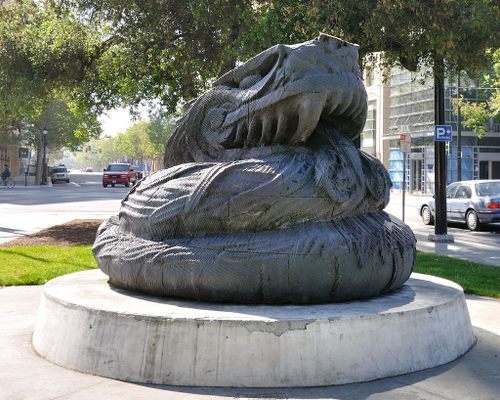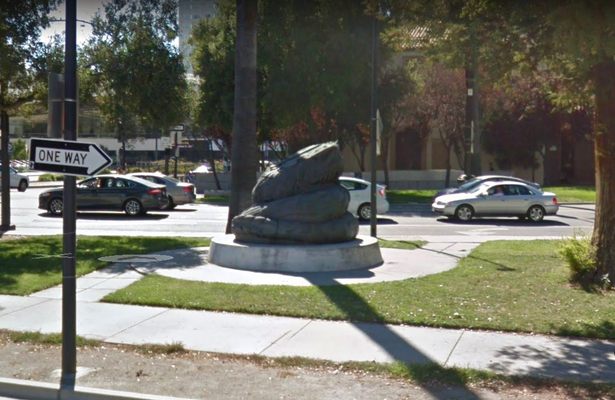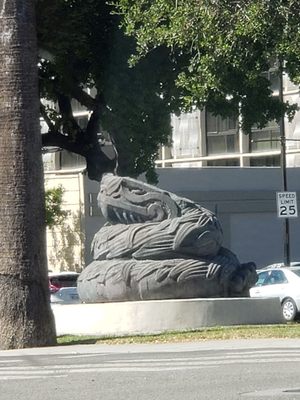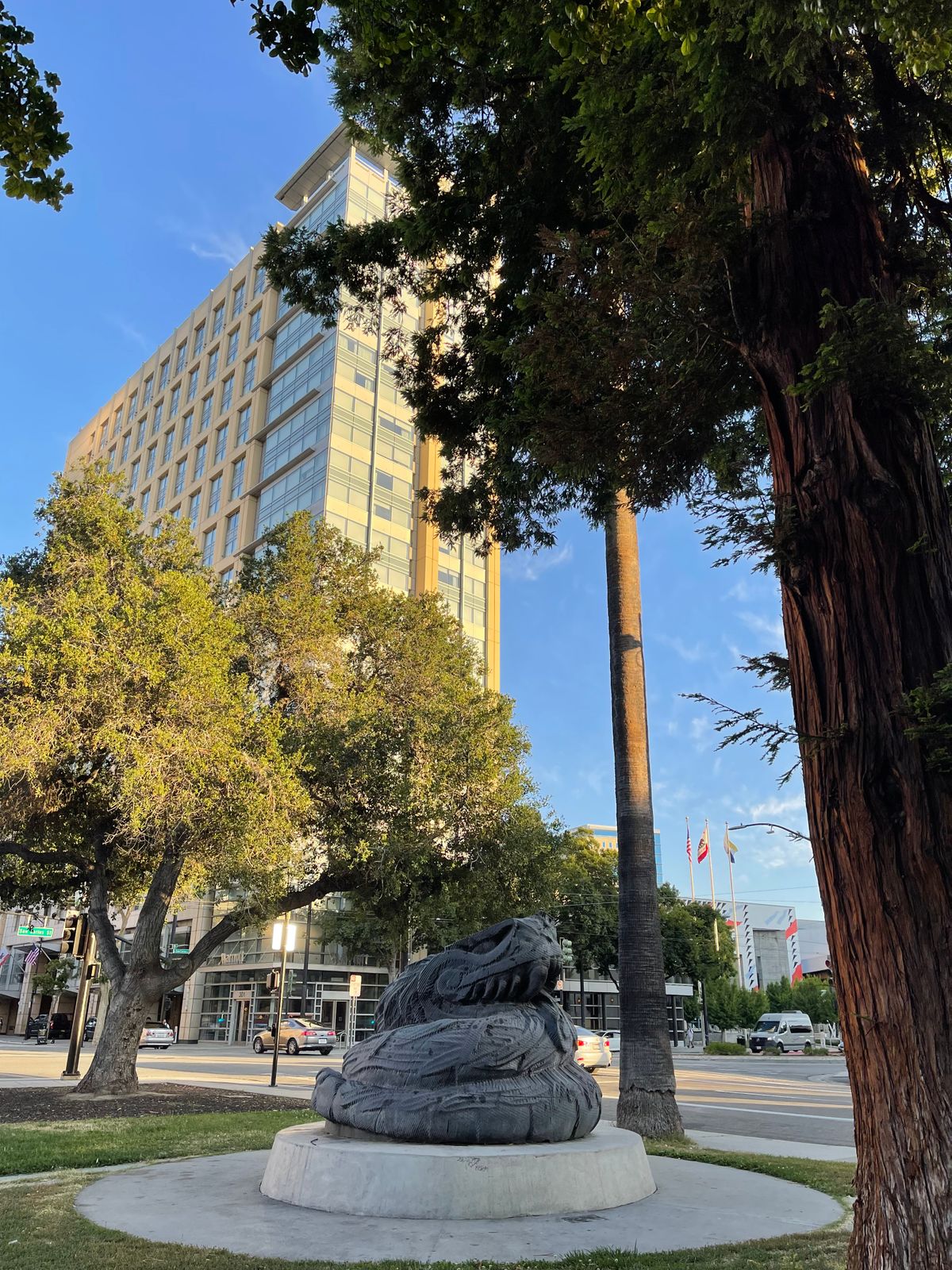About
The controversial Quetzalcóatl sculpture in downtown San Jose inspires love, loathing, and laughter in just about equal measures. But was this excremental artwork a genuine homage to Aztec culture, or payback in the form of poop?
Plumed Serpent, aka the Quetzalcóatl sculpture, aka the poop statue, was created by the Mexican-American sculptor Robert Graham. According to the artist’s website, it is "a stylized image of Quetzalcóatl, one of the most important mythological deities of the Mesoamerican pantheon, and was created for the city "to symbolize the spirit of social harmony and diversity."
But in 1994, when Plumed Serpent was unveiled to the public in San Jose’s Plaza de Cesar Chavez, social harmony wasn’t exactly the phrase of the day. Even before it was unveiled, the statue was drawing stern criticism.
The cost, a cool half a million dollars, was very much a talking point. Weren’t there better ways to spend the city’s money than on a piece of public art? And all this coming about 15 years after the city’s mayor approved a $440,000 equestrian statue of Thomas Fallon, only to see it warehoused for more than a decade (local groups complained that Fallon, a former mayor of San Jose, represented American imperialism and repression of the Mexican population).
Complaints also poured in from both sides of the religious spectrum. Christian fundamentalists were riled up by the very thought of a statue of Quetzalcóatl, who they argued was a grotesque symbol of human sacrifice who enjoyed tearing out still-beating hearts with his lava-rock axe. They were wrong about this, but no one was able to convince them otherwise. Nathan Hill, the host of a local Christian television news magazine, even predicted that the sculpture would turn the plaza into the site of modern-day human sacrifices, with homeless people being the first victims (and in case you’re wondering, there have yet to be any human sacrifices in Plaza de Cesar Chavez).
Non-religious groups, meanwhile, were complaining that the statue of the god Quetzalcóatl was an illegal promotion of religion on public property. They later filed a lawsuit, but a federal court rejected the claim.
The statue’s intended location also raised plenty of eyebrows. In order to place the statue in Plaza de Cesar Chavez, the existing firefighters’ memorial bell would have to be moved. This was seen as highly disrespectful by some, but it was nonetheless relocated to St. James Park and later to Fire Station #1 on North Market Street.
All this controversy, and the statue hadn’t even been revealed yet. And not even the people who had commissioned it knew exactly what they were getting until just six weeks before the unveiling. You see, back in 1992 Robert Graham told the city he was going to build them a 20- to 25-foot-tall bronze sculpture of the Aztec feathered serpent god Quetzalcoatl. Its wings would be outstretched, the entire thing perched magnificently on a base 15 to 20-feet in diameter. But then, in a sudden artistic swerve, he went in a different, far more scatological direction, something that stunned some of the gathered supporters and protesters at the statue's public unveiling.
Graham later said that the change was inspired by a trip to Mexico. And it’s true, some Aztec coiled snakes do indeed bear a resemblance to coiled, cartoon-like excrement. In fact, the English novelist, poet, and playwright D. H. Lawrence described these very same serpents as “snakes coiled like excrement, snakes fanged and feathered beyond all dreams of dread" in his 1926 novel The Plumed Serpent (the same name, coincidentally or not, as Graham’s statue).
Not everyone sees Graham’s supposed sudden change of direction as entirely genuine. Some people argue that the poop-like statue was in fact a form of revenge for a rebuff received by Graham in the late 1980s. Back then, Graham submitted designs and models for gateways to downtown San Jose. These included 30-foot-tall inverted L’s topped by trees, and life-sized bronze horses. The city approved the design, but local media ridiculed the project. The city caved and abandoned the whole idea, paying Graham $60,000 for his fruitless (apart from the cash) endeavors.
This slight, if you’re inclined to believe the rumors, was the cause of Quetzalcóatl’s ultimately turd-like form: a perhaps not-so-subtle middle finger to the institution that had rejected his previous proposal years before.
Related Tags
Know Before You Go
The statue can be seen ready to strike on the southern end of the plaza, where South Market streets meet San Carlos, facing directly across from the historic Sainte Claire building, (housing the Westin Hotel).
Community Contributors
Added By
Published
April 11, 2018
Sources
- https://www.mercurynews.com/2017/08/23/san-joses-quetzalcoatl-the-story-behind-the-statue-we-love-to-mock/
- http://www.sanjose.com/underbelly/unbelly/Sanjose/Quetzy/quetzy.html
- http://articles.chicagotribune.com/1993-10-10/news/9310110022_1_feathered-snake-plumed-serpent-aztec
- https://stanforddailyarchive.com/cgi-bin/stanford?a=d&d=stanford19941121-01.2.32&e=-------en-20--1--txt-txIN-------#
- http://www.christianitytoday.com/ct/1994/september12/4ta062.html
- http://www.robertgraham-artist.com/civic_monuments/plumed_serpent.html


















































